Back in the late fall of 2021 I spoke with the Mikael Frisell and Per Norgren of the Swedish Defence Materiel Agency (FMV) on the future of Swedish (and Finnish) small arms. The blog post offered rather detailed insight into what the Swedish plans were at the time, and now one and a half year later it is time to revisit the topic following Sweden’s (and Finland’s) signing of a joint framework agreement with Finnish small arms powerhouse Sako (part of Beretta Defence Technology). With that in mind, I sat down for a phone call with Hans Allenberg about where the project is now, what choices have been fixed and which are still open, as well as where they are heading next. So sit down in your comfortable chair and pour yourself something nice, because this will be a long one.
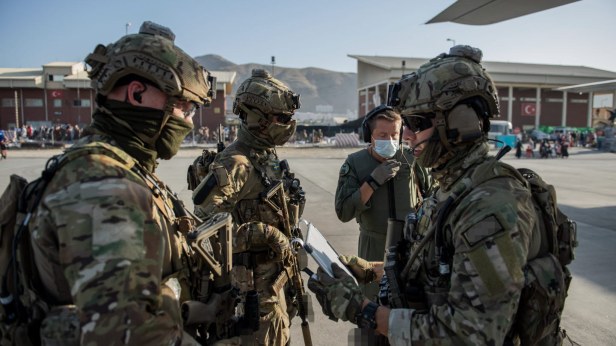
This time, it will be AR-platforms all around. “It’s a conscious decision on the part of both Sweden and Finland that we want a family of firearms where the controls are the same. Instead of having for example an MP7 [as PDW], as assault rifle an AR-platform, and a third weapon as a designated marksman rifle, you get the benefit of if you know one weapon you know all three. You can handle it, you know how it works, you can load it, you can unload it,” Allenberg explains.
The one exception is the Sako TRG M10 in .338LM which have been acquired by both countries this spring. For Sweden it will replace the trusty Accuracy International Arctic Warfare in 7.62 NATO (locally known as PSG 90). 200 rifles have been ordered by the Swedish Armed Forces in the first batch, with the possibility of further orders in the coming years looming large. For Finland the 11 MEUR order for an unspecified number of systems will introduce the M10 alongside the older TRG 42 (locally designated 8.6 TKIV 2000), and a noteworthy if small detail is that thanks to the new weapon and equipment, the TRG M10 system is said to have an effective range of 1,400 meters compared to 1,300 meters for the TRG 42 according to how FDF looks at both systems. Sweden will get their first rifles late this year – likely November or December – which will be followed by acceptance tests and delivery to the Armed Forces in 2024.
If the TRG M10 is an established system, the second weapon to enter Swedish service will be a new one. The first assault rifles chambered in 5.56 NATO with short 11.5” barrels will reach the country for trials later during 2023, following which FMV’s test and evaluation unit will run a serious battery of quality assurance testing according to NATO’s D14-pattern of testing. These so called “You make it, we break it”-tests will see a number of weapons tested to destruction to ensure that e.g. barrel life lives up to the agreed upon standard, and is something that is done for all new weapons delivered to the Swedish Armed Forces. “I am completely certain that the firearms will pass the tests,” Allenberg notes, and provided he’s right the process will then move on to ordering a pre-production series of a few hundred 5.56 NATO rifles for the Armed Forces which will be delivered to FMV during 2024 and on to the Armed Forces in 2025. Delivered to a number of units and schools, the pre-production run will be used for a series of field trials under the auspice of FMV to nail down the final configuration of the production standard. Allenberg describes the test as “quite comprehensive”:
Based on these one can then start thinking about what barrel lengths those carried around in a CV 90 should have, as an example. What works for them? Do they need a different buttstock, or something along those lines. Which sensors should the weapons have? Everyone will obviously get a red dot, but you can also imagine cases where some soldiers get suppressors, some soldier might get a bipod, and so forth and so forth.
Speaking of buttstocks, one of the particularities of the AR-family is that the buffer extends quite a bit back. Without going into details on how the weapon works, the mechanism of an AR-rifles extends far enough back that traditional foldable stocks won’t work, and while there are some solutions to the issue – and to oversimplify things these mainly work through breaking down the mechanism and keeping half in the buttstock and half in rifle – these aren’t perfect. “There is today no sensible foldable buttstock to an AR which allows for firing the weapon while folded, but we are looking at several alternatives,” Allenberg notes, an answer that is likely to upset some people. “All weapons will be fitted with some kind of adjustable or telescopic buttstock, but just how it will look is not locked in.” But if the likely lack of a foldable option will cause some controversy, it’s nothing compared to the next weapon in the family.
People calling me wrong on the internet is nothing unusual, but seldom have I received the number of “You’ve clearly misunderstood things” I got following the last interview with FMV where I broke the news that the Swedish Armed Forces are looking at 7.62 NATO as an alternative for their upcoming assault rifles. Sweden reverting to a heavier calibre stirred some waves, in particular as the talk of the joint program with Finland seemed to indicate Finland would be headed down that road as well (we’ll get back to that).
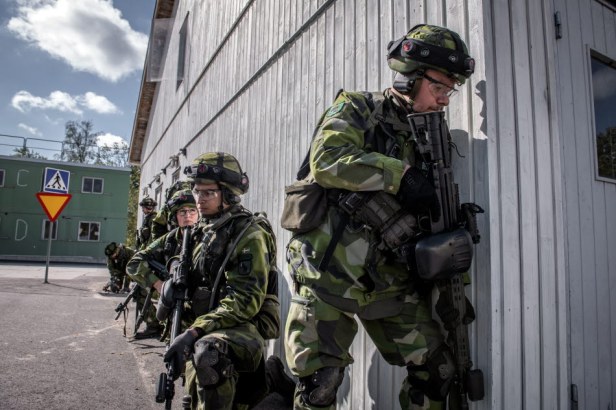
The end result is somewhat more complex than “Sweden reverting to 7.62 NATO”. To begin with Sweden never ditched 7.62 NATO, as it is still the main calibre of the Hemvärnet (the Swedish Home Guard) which sports approximately 40 battalions. In addition, much like the US Army looking at 6.8×51 CC (.277 Fury or 6.8 Common) for “close combat forces” – mainly infantry but also some other soldiers expected to be in the thick of the fight – the Swedish Armed Forces is not looking at handing everyone a 7.62 NATO rifle. Instead, troops which are either not expected to use their weapons much (e.g. if you are doing staff work, serving as vehicle or boat crew, or working with a heavy weapon system such artillery) or that have ample additional medium and long-range firepower at your disposal (such as mechanised infantry) will likely be handed the 5.56 NATO version of the new assault rifle. On the other hand, if you are in a unit which don’t have too much in the way of supporting fires and is expected to fight at long ranges, 7.62 NATO is likely to be found in your future (with the deliveries starting approximately a year later than those of the 5.56 NATO version). To let Allenberg explain the principle in his own words.
I am quite confident that 5.56 mm will be the common weapon for the majority, [meaning it will equip] infantry and mechanised units, command units, those who don’t have infantry combat as their main task, and those who have other weapons – the mechanised at the end of the day have a 40 mm cannon, at least one general purpose machine gun, a recoilless rifle, NLAW, and light anti-tank weapons. It’s not too many of the infantrymen who will use their assault rifles in combat. It is when they go into close combat, when they take their target, or enter a building to kill the enemy. Then we are talking about short distances, and then 5.56 mm still works. However, there might be other units, maybe ranger units or the newly created infantry units in Falun and Sollefteå among others, where you may have to rely on being able to achieve effects at longer ranges. This in turn is based on the Swedish Armed Forces having done an analysis that they want to be able to pierce modern body armour at range, and then 5.56 mm is inadequate.
The obvious follow-up question is whether this means the Hemvärnet will continue to use 7.62 NATO for the majority of their soldiers?
It’s a possibility, I don’t know yet, but it could be a logical conclusion.
Here he is backed up by Joachim Peru, weapon’s officer of Hemvärnet, who in a long interview with the Swedish podcast Militärsnack recently stated that he envisioned a large number of 7.62 NATO rifles in the force.
When discussing being able to achieve desired effect at range, it might be worth remembering that the Sako AR-family actually broke cover a while back with the FDF acquiring what became known as the 7.62 KIV 23 and 7.62 TKIV 23 semi-auto designated marksman and light sniper rifle. This one is also set to enter Swedish service as their new DMR, replacing a G3-version known as AK 4D in the role, though notable is that Sweden reportedly is looking at more traditional DMR-barrels lengths of 18” and 20” compared to the Finnish 16”. It is however further down the list at the moment, and no Swedish orders have yet been placed. Being covered by the framework agreement, Allenberg’s estimate is that it will enter service around 2026 or 2027, getting the designation SSG 26 or 27 (from Swedish Skarpskyttegevär). In the meantime, the G3 (AK 4 locally) is set to soldier on, and it might yet undergo some modifications before being phased out, as “AK 4 in general has proven to be almost indestructible, so there’s much that can be done to modify and keep it in good shape through relatively minor changes.” Allenberg also stated that depending on how the production schedule plays out, a stop-gap rifle may come into play at some point, though nothing is decided either for or against that option.
While Allenberg emphasise that the optics and sensors in general won’t be determined before the end of the field trials, Peru states that some of the non-DMR 7.62 NATO assault rifles will come with optics sporting fixed 4x magnification, straddling the border between ‘regular’ soldiers and designated marksmen. Adopting the kind of true fire control systems such as the Vortex XM 157 which together with the new 6.8 mm calibre is a key part of what the US Army expects will allow their soldiers to be able to engage the enemy efficiently at greater ranges is however not in the cards for the time being for Sweden according to Allenberg.
Interestingly, Sweden is the third of Finland’s neighbours who is to replace the G3/AK 4 with an AR-platform, with Norway going for the HK416 in 2008 and Estonia acquiring the R20 Rahe in 2019. While the HK416 requires no further introduction, the R20 is a more exotic choice, being built by Lewis Machine & Tool who earlier has supplied rifles to the New Zealand Army as well as to the Brits in the form of the L129A1, a DMR chambered in 7.62 NATO. LMT has made some interesting upgrades to enhance modularity, as well as developing a new-style Enhanced Bolt Carrier Group. The latter is however not used for the Estonian contract, as these are short-stroke piston rifles.

Most ARs found in the world today sport what is usually referred to as direct impingement (‘DI’) actions, in which expanding gases are led back into the receiver. However, there are a number of short-stroke piston operated systems as well, of which the HK416/417 family is the most well-known. Die-hard AR-fans have a tendency to feel very strongly about DI being the ‘real’ system for the AR, as it was how Stoner designed it. However, the short-stroke piston has some benefits (at the cost of higher weight), in particular when it comes to the cleanliness of the gun, the ability to use very short barrels, as well as when using a suppressor, so which system is preferred largely comes down to the particularities of the use case (and if you really want to see the world of a ‘DI or nothing’-fan crumble, point out that in Stoner’s original 1956 patent he refers to the bolt acting as a “stationary piston”, meaning that all guns are piston driven at the end of the day).
In any case, both Norway and Estonia opted for short-stroke piston designs, as is the case for Finland and Sweden with Allenberg confirming all guns in the family will be using that system.
The R20 (and the LMT MARS-rifle family it is based on) is according to all accounts an excellent weapon. An Estonian reservist I discussed the question with noted that:
It’s certainly not news to anyone who has practice with similar weapons, but I was absolutely stunned by the difference between the R20 and AK 4. The AK 4 is great for it’s time, but it was built when people were generally not using body armour, so getting a stable firing position is actually quite tricky for a short guy like me (174cm).
He went on praising the ambidextrous controls, which while particularly helpful for left-handed shooters also benefit right-handers in allowing for the use of either the thumb or the index finger depending on where the safety is pointing and where you want to move it. However, “the safety switch and the huge travel-distance of it, particularly in the rare cases you need AUTO is IMO one of the weakest parts of the AR-15 design. I liked the G3 one much more on the AK4 (despite it being on the wrong side for me).” Which is interesting that he brought this up, as one of the few external features visible in the renders that seems to set the new Sako-rifles apart from the competition is a shorter throw on the safety switch. While the R20 and HK416 both use a 0°-90°-180° sweep, the Sako seems to have what I assume is a 0°-60°-120°.
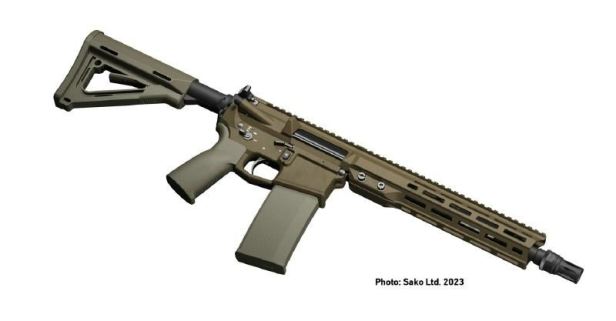
But speaking of the HK416 and R20 – why bother with a new AR-model when the world is full of nice manufacturers? Both the Swedish special forces and the Finnish Border Guards already use the HK416-family (Swedish SOF having earlier used the legendary Colt Canada/Diemaco C8 carbine, and now also use the LWRC M6), and it isn’t like there’s a shortage of high-quality manufacturers on the market. The answer comes down to security of supply and a desire to build upon the close bilateral cooperation between the two countries. When the program kicked off, all options were on the table explains Allenberg, including Sako.
Sako was involved early as an interesting competitor, and when we had decided on which platform we wanted to move forward with, the choice was rather straightforward.
The production line will be in Riihimäki, with the ability to do maintenance and overhauls in Sweden. The Swedish authorities will also have all necessary drawings, ensuring redundancy for both the Finnish and Swedish forces in case something would happen to the current factory (Allenberg didn’t dwell on the question, but I assume he is referring to both natural and man-made issues, such as, well, cruise missile strikes). However, there is no active plans for any kind of production in Sweden. Part of this is also thanks to Finland and Sweden being out of sync when it comes to their particular needs – Finland goes for the DMR first and only later will we replace the current AK(M)-based rifles, while Sweden is rotating out their FN FNC (AK 5) and H&K G3 (AK 4) first and as mentioned only later acquiring the DMR. This should ensure that Sako’s production line isn’t quite as swamped as it would be if both countries placed huge orders for assault rifles at the same time – though it will certainly require a bit of a push for the company that hasn’t had a military order of this scale for quite a while.
So is Finland then getting the same package as Sweden? Yes, and No.
The basic premise is that “a Finnish soldier is to be able to walk into the depot in Boden and get a spare part for a Finnish rifle, and the other way around, a Swedish soldier is to be able to walk into the depot in Rovaniemi and get a spare part, to somewhat oversimplify the principle.” This does not mean that everything is exactly the same. Both countries have their own preferences when it comes to exact colour and the accessories chosen, but the modularity of the modern AR means that this isn’t an issue. When it comes to calibre, Finland has not shown any particular interest in 7.62 NATO, and Allenberg’s own guess is clear:
I am completely convinced that Finland will convert to 5.56 NATO as standard.
At the same time, it deserves to be said that colonel Juhana Skyttä, the inspector of infantry for FDF and the officer in charge of small arms programs, in an interview with MTV stressed that the final choice of calibre is still open, and mentioned that they are obviously also following the developments in US with regards to 6.8 Common. The interesting detail here is that 6.8 Common and 7.62 NATO have the same external dimensions, allowing for converting a weapon between those calibres with a change of barrel – if the gun can handle the pressure. The secret sauce of the wonderful performance of the 6.8 Common is that the pressure is high. In fact, it is high enough that traditional brass cartridges don’t want to play game, so it sports a hybrid case with a steel case head, brass body, and an aluminium locking washer. This also means that almost no 7.62 NATO actions won’t be able to handle the pressure if you tried converting them to 6.8 Common.
But Sako’s AR ain’t most guns.
“Yes, I would say that we are,” was Allenberg’s response when I asked if switching to 6.8 Common down the line was an option if it becomes a success. “We haven’t had the possibility to do tests and evaluations with those rounds yet, but we have run the theoretical calculations.” The framework agreement is written to be rather open in what it covers, so a change of calibre does not require renewed negotiations. This also means that if production of the new rounds have reached an amount that allows for export and the US is happy to export them to its northern European friends, 6.8 Common could well be in use among certain Finnish or Swedish units down the line, either in new-built or in converted rifles (and notable is that the ability to switch out barrels also makes training with 7.62 NATO rounds a cheap option compared to using the real deal).
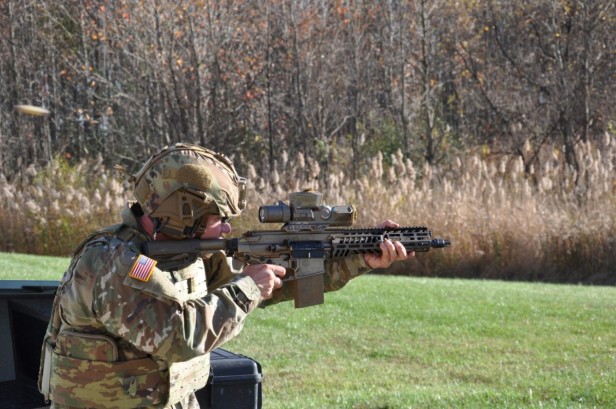
With regards to designations, Sweden is ditching the expected AK 6 and letting the assault rifles fall in line with the rest of the small arms in using a type designation followed by year of introduction. For the time being the naming of the 5.56 NATO assault rifle is still somewhat uncertain, with the official designation right now being SSV 24. However, as SSV stems from the Swedish designation for PDWs (Självskyddsvapen), and as the 5.56 assault rifles certainly ain’t that, a change to the ‘proper’ name isn’t ruled out.
I hope that they will rethink it. As for now, it is SSV [PDW] that’s official […] The weapons we buy are assault rifles according to the definition, even if some of them sport a rather short barrel […] At the end of the day, it’s the Armed Forces’ call, what they want to designate their weapons.
Allenberg notes that he personally would prefer something like the AK 25K (Kort, Swedish for ‘Short’) or simply using running letters for different versions as has been done with both the AK 4 and AK 5. It remains to be seen if the Armed Forces agrees with him. What is clear is that when the mechanised infantry jumps out of their IFV, they will be wielding an assault rifle and not a PDW, regardless of how it is named.
All in all, the next few years will see serious changes to the weapons wielded by most Finnish and Swedish soldiers, and while some issues are still open, one thing is clear to Allenberg.
I really want to emphasize the stellar cooperation we have had with the Finnish Logistics Command, the Finnish Defence Forces, the officers we’ve worked together with, and created this agreement in partnership with. It’s an outstanding professionalism, and a readiness and will to both give and take […] both sides really want what’s best for this program, and it’s a great collaborative effort.

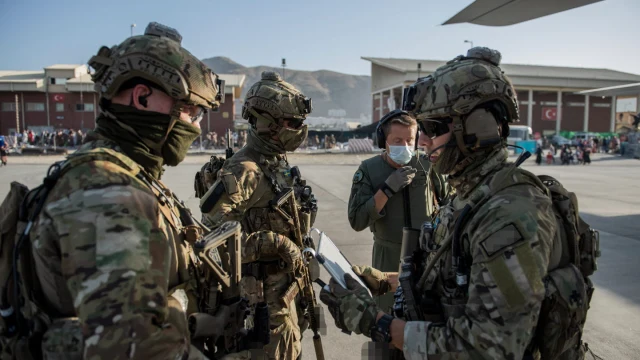
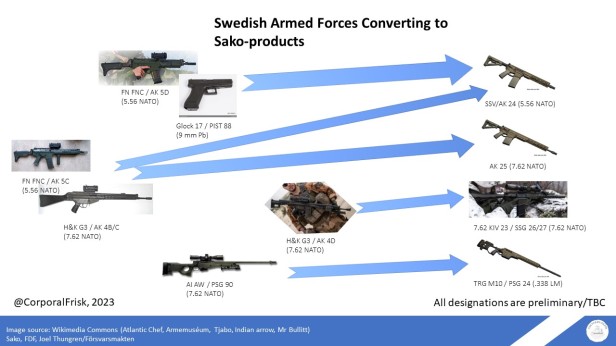
An interesting article, thanks for that!
Are there any hints about thermal sigths, nattsikten, IR over Vortex157?
Happy Easter
Phew, not Finland joins NATO (without Sweeden, but congratulations) but a gun debate.
Their are two big aspects of DGI. One is the spring in the rear that means no folding butt-stock. With a HK-416 or like, that solves that for infantry in an IFV or any other vehicle. The other being cleaning and keeping clean the interior of an DGI that is going to be far easier in a Northern Climate that is not sand (and cooler by a lot) but still with conscripts the less the better.
The USMC has morphed into the Short Stroke HK (Mk 24 IAR).
Clearly the mfg aspect is to keep gun mfgs going in Finland and no issue with that though it will add cost.
Assessing terrain and combat in Scandinavian is ? Forrest and wide open and I don’t know how much (Alaska is fairly well forested until 100 miles or so from the North Edge) though there are other areas of wide open.
The Short Barrled 5.56 suffer a lot in reach.
I do have to laugh about an increase of 100 meter for the sniper guns, like anyone can tell? By the time you are out at those 1500 meter ranges the drop is 40 inches or more. As much luck as anything at that point.
I do take umbrage (not with Fisk) for an Optic being called a Fire Control Group. That has alwyas been the firing mechanism. Fire Optic would be a far better term.
I should add in that I don’t see an issue with Finland/Sweden making 6.8 ammo, certainly more than have the capability though it will be a few years away from Sig turning it over to the US Army (assuming the 6.8 works, its a heavy weapon and going to be a shock from the 5.56)
I have fired a fair number of the Semi Auto assault rifle variations, the best on the controls was a gun called the XCR (Robinson Arms) which is a modern take on the AK with a long stroke piston, all the controls were easy to hand unlike an AR or an AK. Shot an AK as well, lets just say it seemed rugged but the controls were all laid out wrong.
All the newer offerings have AR type controls, not that I like them but it gives many comfort though if you learn how to fire a gun from the ground up as it were then its normal.
The purists get their undies in a twist when the AR platform is referred to as a DGI. They insist its not but its so close to the idea it realistically is. They have taken over even Wiki in their stampede. No reason not to call it DGI as it does vastly differ from a true Gas Piston design.
An AK would be a long stroke gas piston, the HK would be a short stroke or tappet gas piston and the AR puts gas right to the bolt in the carrier group that is truly a different form and the term DGI suits it well.
Its a shame others don’t chime in, the area is a major subject and the US move to the 6.8mm as well as the very heavy rifle goes with it.
Of note is what I call the fire optic as it turns each infantryman into a sniper. Automatic fire is seldom used in the M-16 type weapons (now). The professional US military found what has alwyas been true, burst use up a lot of ammo and at ranges beyond 30 yards, mostly miss. The US issued 3 round burst limited M-16 at one time.
A machine gunner can deal with that through training and discipline but that is bipod or tripod support.
One not reported aspect of the US 6.8 rifles is they come with a suppressor. Those are almost unbelievable in how much they quiet the largest cartridges (300 Win Mag, 333 Lapua and the like)
One answer to the need for compact vs generally effective is a folding stock weapon. Something I would have to review, I don’t know that any of the short stroke type have that (the AK47 and its derivatives do have that). A bullpup design also does that but its not well liked for some of its drawbacks.
Some of the AR manufactures have dropped the forward assist as it adds cost and has little use to clear a jam as it only makes a problem worse (clear the action, fix the problem if not just a round and then you are functional)
The Sig 6.8 rifle has that as well as the awkward rear charge handle though they also have a non reciprocation side charging handle.
I don’t buy the commonality of the appearance or mechanism, guns of that type are not hard to reload or fire and the better the ergonomics the easier it is to shift.
The rear charging handle solves on aspect of use and that is for left hand shooters though you still have the port in your face aspect. A non bullpup design gets it further away from your face.
I am inclined to thinking the US Army needed to shift to a 6.5 mm such as the Creedmore or the 6.5 x 47 Lapua (Creemore is a bit bigger case) as a better intermediate cartridge.
How relevant penetrating personal armor is at 800 yards is a tough one, the Fire Optic does allow you to hit at those ranges (its all computer controlled). Keeping in mind if you have a rifle that is 1 MOA (1 inch group at 100 yards in the US) you are still 8 inches off at 800. That takes a very steady hold to achieve that and that is very situational as far as capable (snipers have their leisure to do so, an infantryman no so much).
The Thompson, Schmeiser and the post war Uzi were popular as it gave a person rounds to throw at shorter ranges. The M1 carbine was the largest mfg US rifle as it was better than a pistol and aimed better than the bulkier and heavier M1 Garand with its 30-06 cartidge which was reciauloy long ranged to little use in WWII (WWI they used are suppression from 30 caliber machine guns but that changed with Mortars).
My take on the US 6.8 round is it was solely designed with the strange base so it was compatible action wise with 7.62 NATO (in the US the civilian version was 308 Winchester).
Ironic to see us going back to what was a 30-06 cartridge in the 7.62 type as it emulated a 30-06 in a shorter case for a 150 gr bullet that the newer powders post WWII allowed.
Another area is what is referred to as lethality of the bullets, that is a bust in military terms as you cannot get a bullet that has a massive wound affect and armor penetration so regardless of calibers, they poke holes in people not a hunting type round that is intended to kill the game as quickly as possible.
Of note I have long followed European arms as my folks got a Sako Finbear hunting rifle when I was a kid.
Keeping arms going in Europe is a legitimate goal and there equally many ammunition producing companies that support them.
The bigger issue is the large equipment and failure of common production industry so it can be done on US scale.
Of some interest is Romanians looking to acquire the M1 Tank.
The USA adopting XM7 + the new 6.8mm round has to be one of most bizarre decisions I have seen a military do for a very long time. Just goes to show you that the Americans unfortunately have the “cult of the rifleman” always hanging over their head as a sort of Sword of Damocles as that cult always dictates their small arm designs especially during “peace times”. Time and time again, the USA enters into a conflict deluding themselves that the tenants of the cult of the rifleman are supreme before being violently reminded that volume of fire (and it’s brother explosive firepower) are superior instead; begrudgingly, the USA will adapt during the war with the process starting all over again when the conflict ends and the cult get it’s way again in the post war years. Look at the Vietnam War, the USA entered into the war with the M14 (a heavy and bulky target rifle, with heavy, bulky and high-recoil ammo) before promptly replacing it with the original M16/M16A1 (an excellent lightweight combat rifle weighing around 6.4ish lbs with full auto and light and soft shooting ammo) then after the war adopting the Godawful M16A2 (a heavy 8.3ish lbs target rifle with it’s offensive burst setting) because the cult of the rifleman forced in the preceding years.
Yet here we are again, with the USA adopting a heavy, bulky, and extremely overpowered rifle to replace it’s lighter M4A1s with their lighter and soft shooting ammo. As per wikipedia, “compared to the M4A1 weighing 6.34 lb (2.88 kg) unsuppressed with a basic combat load of 210 rounds in seven 30-round magazines in total weighing 7.4 lb (3.4 kg), the XM7 weighs about 2 lb (0.91 kg) more and each soldier carries roughly a 4 lb (1.8 kg) heavier load with 70 fewer rounds.” Fitness standards have collapse for the USA military and more women are entering into combat roles, but now they want to adopt an even heavier rifle with an even heavier combat load? Absolutely baffling. Meanwhile most combat still occurs under 300m and most soldiers still want more ammo for combat and not less.
The USA had an excellent chance to replace both the 5.56/7.62 with a 6mm Universal cartridge (which the Chinese did and the Soviets wanted to do before they imploded) because a 6mm SAW/ARC round would out perform the 7.62 at 800m+ while being in similar weight and recoil to the 5.56. A redpill that a lot of people do not want to shallow is that under 300m, the 5.56 and 7.62 perform equally the same on human targets (there is a study out there that confirms this but I cannot find it offhand) which means a 6mm Universal round would perform the same as the 5.56/7.62 at 300m but also give extra juice to 300m+ shots when they do occur (performing closer to the 7.62 at longer distances).
Meanwhile, the US Marines is avoiding this insanity by adopting the M27 (a fancy German full auto M4) and giving every squad a MAAWS (congrats to finally matching the firepower of a 1960s USSR motor rifle squad!) which means they can partake in the cult of the rifleman during peace time and when they do find themselves in another conflict, they will be actually prepared with proper equipment.